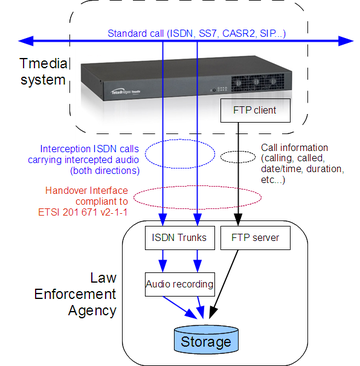Tmedia Lawful Intercept
m (Replaced FreeSBC with ProSBC) |
|||
| Line 5: | Line 5: | ||
The TelcoBridges products support Lawful interception based on the following specification: ETSI 201 671 v3-1-1 (since version 3.0.122).<br /> | The TelcoBridges products support Lawful interception based on the following specification: ETSI 201 671 v3-1-1 (since version 3.0.122).<br /> | ||
| − | [[Tmedia]] products support Lawful intercept over SS7, ISDN, CAS, Sigtran and SIP signaling interfaces. [[ProSBC]] supports lawful intercept for SIP. | + | [[Tmedia]] products support Lawful intercept over SS7, ISDN, CAS, Sigtran and SIP signaling interfaces. [[FreeSBC|ProSBC]] supports lawful intercept for SIP. |
Latest revision as of 08:55, 30 July 2020
Starting with Toolpack version 2.7, the TelcoBridges product line has built-in lawful intercept capabilities that allows service providers to keep doing their core business and meet government regulation in a single box.
The TelcoBridges products support Lawful interception based on the following specification: ETSI 201 671 v3-1-1 (since version 3.0.122).
Tmedia products support Lawful intercept over SS7, ISDN, CAS, Sigtran and SIP signaling interfaces. ProSBC supports lawful intercept for SIP.
Contents |
Functionality Overview
Lawful Interception will identify a call to intercept, and send the following information to one or multiple Law Enforcement agencies:
- information on an intercepted call (calling/called numbers, timestamps, call duration, etc.)
- audio from both directions of the call
Interception of a call is triggered by:
- A phone number to monitor
- A date/time period
A call that matches the number and the time period will be intercepted.
Implementation
With a system running version 2.7 or above, lawful interception is triggered by a routing script. This script uses the information from a configuration file (csv format), to determine which phone number must be intercepted during which time period.
A call that matches the number (calling or called number) and the time period will be intercepted.
During the interception, two outgoing calls toward an interception NAP will be placed, each containing a copy of the audio of one direction of the intercepted call. The specified NAP must be configured to point to the Law Enforcement Agency, generally using ISDN trunks.
In addition, information records (containing general call information like calling/called number, timestamps, and call duration, etc., this information is called Intercept Related Information (IRI) records) will be sent to the Law Enforcement Agency. That information is sent as data files (format specified by ETSI 201 671 v2-1-1) to a FTP server (Toolpack also supports SFTP for more security).
Lawful Intercept configuration (NAP to use, login information of the FTP/SFTP server, target numbers to intercept, etc.) can be configured in the Toolpack Web Portal.
H.248 Implementation
Lawful Interception is also supported using H.248 interface. For Tmedia in H.248 mode, there is no specific setting to configure to support Lawful Intercept except "IP Lawful Interception ToS value" located in advanced parameters.
Configuration
- Toolpack v3.0: Lawful Intercept
- Toolpack v2.9: Lawful Intercept
- Toolpack v2.8: Lawful Intercept
- Toolpack v2.7: Lawful Intercept
